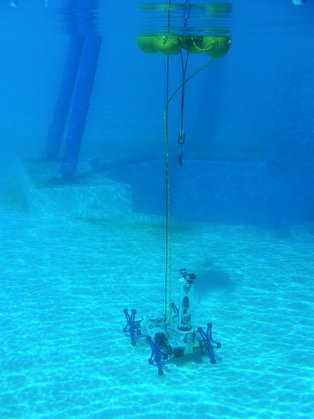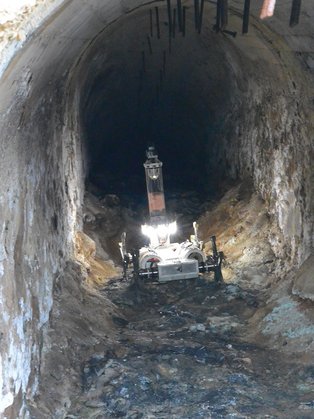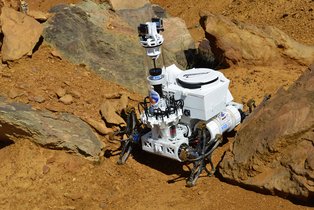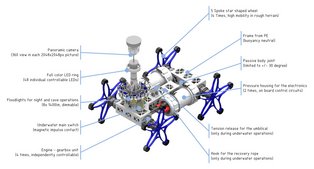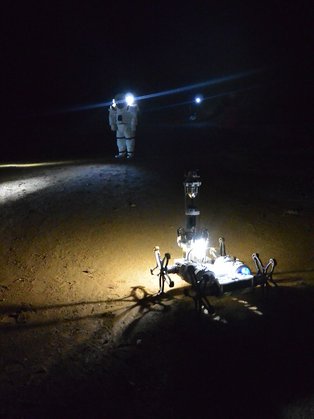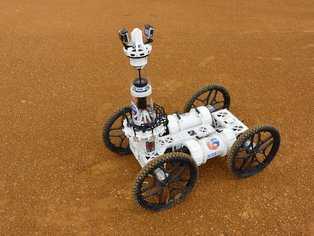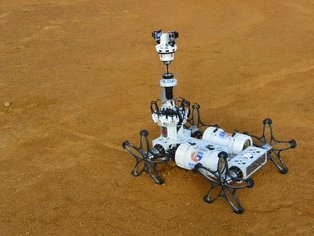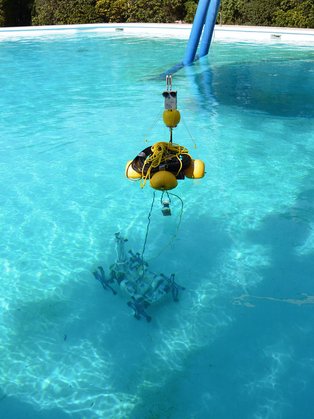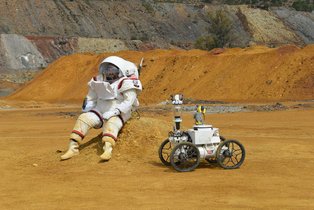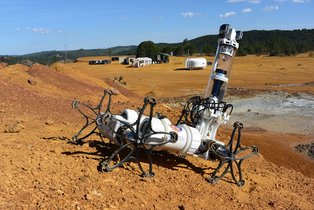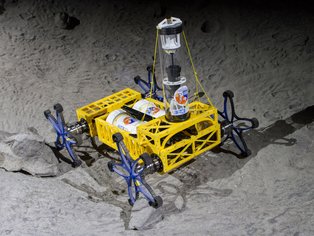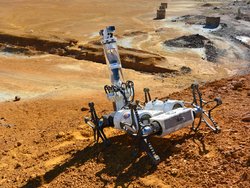YEMO 1.1
Semi Autonomous Micro Rover for Underwater Applications
Contact person:
Technical Details
| Size: | 1.10 x 0.70 x 0.90 m |
| Weight: | Approx. 27 kg (w/o payload) immersed: approx. 4 kg (w/o payload) (payload capacity 10 kg) |
| Power supply: |
Lithium polymer primary battery: 29.6 V, 7 Ah (opt. additional batteries in the surface buoy or use of external power supply)
|
| Speed: | 0.7 m/s |
| Actuation/ Engine: |
4-wheel drive: Robodrive ILM 50x14 BLDC motor with harmonic drive gearing (50:1) for star-shaped wheels (5 legged)
|
| Sensors: |
AVT Mako (2048 x 2048 px, 10 fps) facing at hyperbolic mirror for 360 degrees panoramic view, IMU, GPS
|
| Communication: |
2.4 GHz Wi-Fi access point, 802.11 b/g/n
Underwater: 55m 1GBit Ethernet cable
|
| Chassis: |
Passive rolling joint at the rear axis (limited to +/- 30 degrees)
|
| Structure: |
Optimized for corrosion endurance, water jet cut plastics plates for bearing structure, connected using stainless steel screws, titanium pressure housings for the motors, pressure housings for electronics made from PVC and acrylic
|
| Diving depth: |
50 m
|
| Headlight: |
8 x 13,1 W LED (1416lm each, dimmable)
|
| HMI: |
48 full color LED in a ring for status display (individually controllable)
|
Organisational Details |
|
| Partner: | COMEX, EADS, LIQUIFER Systems Group (LSG), Space Application Services (SAS), NTNU Centre for Interdisciplinary Research in Space, Instituto Nacional de Técnica Aeroespacial (INTA) |
| Sponsor: | European Union |
| Grant number: | The project MOONWALK is financed by the EC Program SPA.2013.2.1-02 under the contract number 607346. |
| Application Field: |
Space Robotics
Underwater Robotics |
| Related Projects: |
Moonwalk
Technologies and Human-Robot Collaboration for Surface EVA Exploration Activities and Training in European Analogue Environments
(09.2013- 08.2016)
|
| Related Robots: |
Coyote II
High Mobile Micro Rover
Coyote III
Advanced Security Guard V2
ASGUARD III
Advanced Security Guard V3
ASGUARD IV
Advanced Security Guard V4
|
| This system is not actively used anymore. | |
System description
The robot YEMO is an underwater micro rover that features extraordinary high agility and mobility at the seafloor. It was engineered based on the already successfully deployed ASGUARD robot platform of DFKI. The central element of the robot’s drive is a passive joint between front and rear axis. This allows a permanent ground contact of all four star shaped wheels. The interaction of the axis and the star shaped wheels facilitates a maximum of agility even in difficult environments. Beyond that, YEMO can not only be deployed on dry land, but also under water in depths up to 50 meters. Since there is no need for special modifications of the system for underwater operations, also amphibious applications are possible without interruptions.
When used ashore, communication is established using a Wi-Fi access point integrated in the robot; when used underwater, an alternative access point can be used, which is in a buoy floating above the robot, attached to it using an umbilical cord. Besides transferring communications, the umbilical cord can also supply the energy needed for operating the robot. Therefore, the buoy carries additional batteries to increase the time of line current independent operation of the robot. Alternatively, the umbilical cord can be connected to an underwater node transferring communications and supplying power. This way, the robot can be deployed and used for long term applications.
Long term applications are facilitated by exclusive use of non-corrosive materials. The robot’s frame and the pressure housings for the electronics are made of plastics; the motor’s housings are made from seawater proof titanium.
The main sensor of the system is a 360 degree field of view camera. This allows a gapless coverage of the entire environment of the robot at all times. This overview facilitates a quick mapping of the robot’s surroundings as well as an alleviated orientation within. Moreover, a position sensor with compass is available. In applications ashore, a GPS integrated in the robot is able to capture the robot’s absolute position; in underwater applications, it can be approximated by the use of an alternative GPS integrated in the buoy. This sensor setup allows autonomous applications, e.g. avoiding collision with obstacles detected in the camera’s images.
Within the MOONWALK project, YEMO is used to test new approaches in the astronaut-robot interaction. Therefore, the astronaut’s suit is equipped with sensors that allow the recognition of gestures performed by the astronaut using arm and hand movements. This gesture input will be used to control the robot, respectively the feasibility of such control approach will be tested in a realistic, earth-analogous simulation. Furthermore, the astronaut has access to a conventional control of the robot using keys and buttons. The robot’s feedback to the astronaut, e.g. about specific recognized gestures, is provided i.a. by a ring of individual addressable full-color LEDs. This way, the astronaut is always able to perceive immediately and intuitively if the robot understood his input or respectively in which mode of operation it is in.
The robot is able to carry a payload of 10 kg at maximum. This payload may be additional sensors, or, like planned in the specific simulation scenarios of the project MOONWALK, a compartment for collected samples.
When used ashore, communication is established using a Wi-Fi access point integrated in the robot; when used underwater, an alternative access point can be used, which is in a buoy floating above the robot, attached to it using an umbilical cord. Besides transferring communications, the umbilical cord can also supply the energy needed for operating the robot. Therefore, the buoy carries additional batteries to increase the time of line current independent operation of the robot. Alternatively, the umbilical cord can be connected to an underwater node transferring communications and supplying power. This way, the robot can be deployed and used for long term applications.
Long term applications are facilitated by exclusive use of non-corrosive materials. The robot’s frame and the pressure housings for the electronics are made of plastics; the motor’s housings are made from seawater proof titanium.
The main sensor of the system is a 360 degree field of view camera. This allows a gapless coverage of the entire environment of the robot at all times. This overview facilitates a quick mapping of the robot’s surroundings as well as an alleviated orientation within. Moreover, a position sensor with compass is available. In applications ashore, a GPS integrated in the robot is able to capture the robot’s absolute position; in underwater applications, it can be approximated by the use of an alternative GPS integrated in the buoy. This sensor setup allows autonomous applications, e.g. avoiding collision with obstacles detected in the camera’s images.
Within the MOONWALK project, YEMO is used to test new approaches in the astronaut-robot interaction. Therefore, the astronaut’s suit is equipped with sensors that allow the recognition of gestures performed by the astronaut using arm and hand movements. This gesture input will be used to control the robot, respectively the feasibility of such control approach will be tested in a realistic, earth-analogous simulation. Furthermore, the astronaut has access to a conventional control of the robot using keys and buttons. The robot’s feedback to the astronaut, e.g. about specific recognized gestures, is provided i.a. by a ring of individual addressable full-color LEDs. This way, the astronaut is always able to perceive immediately and intuitively if the robot understood his input or respectively in which mode of operation it is in.
The robot is able to carry a payload of 10 kg at maximum. This payload may be additional sensors, or, like planned in the specific simulation scenarios of the project MOONWALK, a compartment for collected samples.
Videos
MOONWALK: YEMO 1.1 during the earth analogue simulations

By playing the video, you accept YouTube's privacy policy.
The project MOONWALK concluded with two earth analogue simulations, one a desert area in Spain and the other on underwater offshore the coast of Marseille. The video shows the amphibious rover YEMO 1.1 in action during the trials, including the novel gesture control interface. This allows the astronaut to control the rover with the movements of his arm.
MOONWALK: First sea trials with YEMO 1.0

By playing the video, you accept YouTube's privacy policy.
First functional tests of the new amphibious rover YEMO in the Mediterranean Sea where conducted near Vulcano Island in June 2015. The video shows the rover’s mobility underwater and the advantages of a 360 degree panoramic camera.
